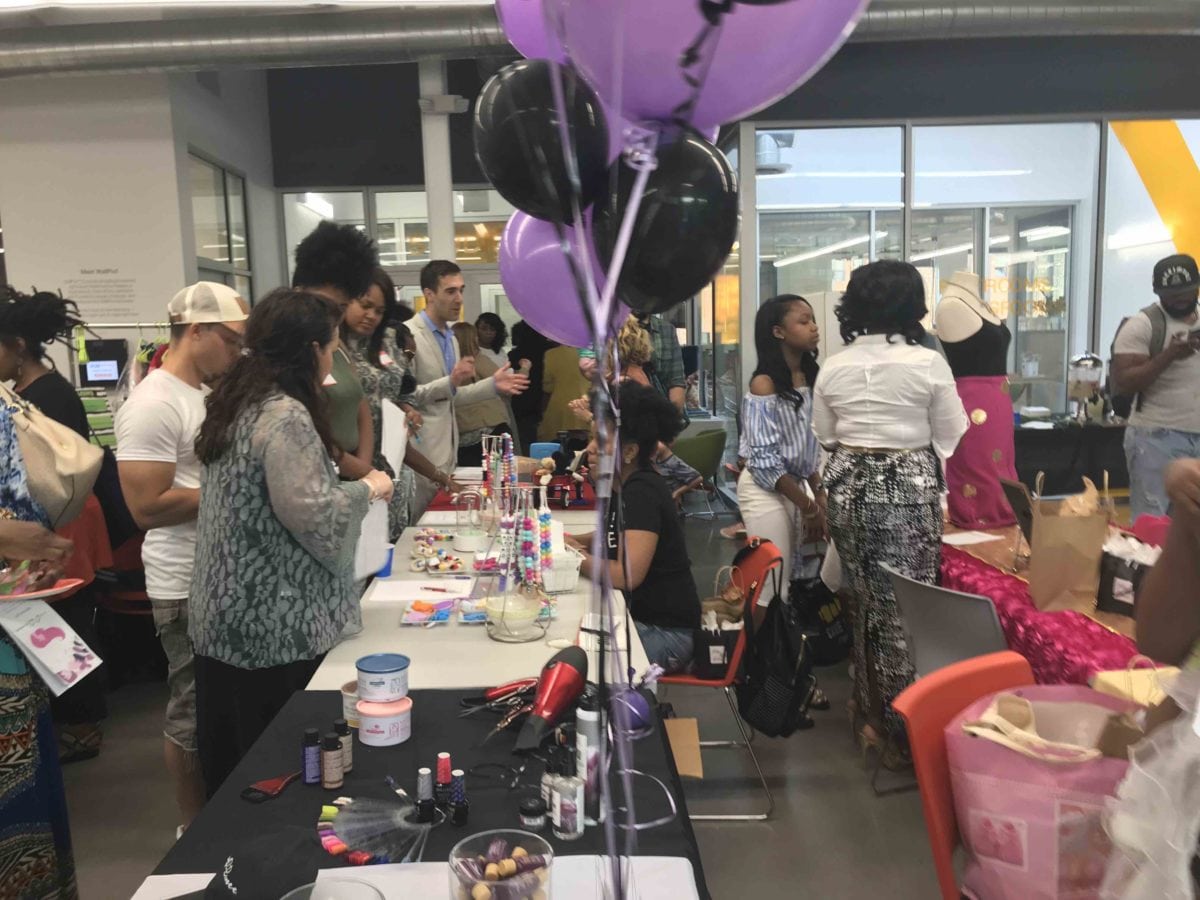When nonessential businesses were ordered to close in Maryland, it meant Nakia Dedmon had to close the two businesses she runs in Randallstown. Since March 23, she hasn’t had any income from Polished Nail & Skin Care Boutique and ELV8 Brows & Beauty.
She’s not alone in needing to shutter, as the COVID-19 pandemic that led to the closures was a force beyond entrepreneurs’ control. So it might reason that she is a prime candidate for the expanded aid programs offered by the government.
She applied for unemployment and was approved in April, but has yet to receive benefits, and could only apply back to April 19. (The system has been riddled with struggles statewide.) She also applied for grants and loans through entities like the U.S. Small Business Administration, but said she didn’t get so much as an acknowledgement of the application.
To Dedmon, it all gives the impression that programs like the SBA’s Paycheck Protection Program (PPP) seem designed for larger organizations: “It’s not designed to help the independent owner, and definitely not a beauty industry professional,” she said.
It shows how federal aid has become a story of the haves and have nots. While larger firms that received loans through the $669 million PPP’s first and second rounds have been called out and some paid the loans back, women and minority businesses have largely been shut out. A federal inspector general found last week that the SBA did not direct banks to prioritize women and minority-owned businesses “as Congress intended” and that entrepreneurs from these groups “may not have received the loans as intended,” a report states.
The services that many of these businesses perform are part of daily routines. In the Black community, many of these are squarely in the “Main Street” category, providing gathering points to bring the community together. But now these businesses are closed, even as many still have to pay rent as folks stay home to stop the spread of COVID-19.
“They are the businesses that are in our community, that are actually driving our economy and also helping with social issues,” said Dr. Tammira Lucas, who started The Cube, a Towson coworking space that’s geared toward parent entrepreneurs and offers child care. “To create a program that shuts them out is very alarming to me because these are the businesses not only impacting our communities but impacting our families.”
The PPP is designed to help small businesses as they’re rocked by a pandemic and economic shock beyond their control. It offers to cover 2.5 times the cost of key expenses like payroll. But when the forms prompted them to fill out the number of employees, many didn’t have any to list. And even though the program was technically able to be accessed by sole proprietors — which as many as 95% of Black entrepreneurs are — forgiveness of the PPP loans is dependent on 75% of the funding being put toward paying employees.
I do believe that the government and powers that be are trying to help. I really believe that we're trying our best. Do we think that there's more that we can do? Of course.
As these sole proprietors in beauty and other services work to build their businesses, many haven’t yet grown to the point of being able to bring on full-time employees. Entrepreneurs in these industries often work with contractors, many of whom also have businesses. It’s the kind of model championed in plenty of segments of the economy as innovative (think: gig economy), and it’s led to a virtuous cycle. And it has also birthed a community all its own to lift up businesses with pitch competitions, daylong pitch conferences and months-long accelerators.
Hiring full-time employees may be a goal, but often comes with time and growth. And, as Lucas points out, many business owners might not even be able to list themselves on payroll. They are often taking little to no salary for themselves initially, since they are putting money back into the business.
But now having employees has appeared to become a key to accessing aid.
“We left out tens of thousands of small businesses because we just didn’t meet the qualifications,” said Takia Ross, owner of mobile makeup artistry business Accessmatized.
And even if they seek out the loans, Ross said she has been reminding her community of entrepreneurs — she runs the annual So You Want To Pitch Conference — that this government aid is “still loans.” And the loan has to be paid back, so it creates a scenario where taking on debt at a time can become “another burden” for entrepreneurs, especially in a scenario where it’s unclear when and if clients will be able to return, Lucas said.
“If you do not have a strong revenue driving plan, you’re putting yourself at an even greater deficit because now you owe people money,” Ross said.
Distributing loans via banks has also created an uneven setup in and of itself. Ross said she works with a smaller bank, which was initially unable to process loans. It’s common among smaller businesses, she said, since the larger banks often charge larger fees. When she went to apply with larger banks for this program, they were “slammed” with their customers with whom they already had pre-existing relationships, she said.
Ross also applied for the SBA’s Economic Injury Disaster Loan, which officials had initially said could provide a $10,000 advance along with the loan. But when rules changed, she ended up receiving $1,000, and didn’t receive a loan.
Normally, spring is the busiest season for her business, as proms, weddings and special events fill up calendars. But with those events canceled and uncertainty around when events will be allowed again, she is also seeing cancellations into the fall.
Ross said she has managed to break even through this time by selling products. She has also seen others offer virtual classes and workshops.
Dedmon has found community with other businesses across the country in forums with other business owners in the beauty industry who are in a similar situation.
“We’ve been trying to encourage clients to purchase products or to purchase gift cards from our websites,” she said. “What most of us have turned to is the kindness and generosity of friends and family members and followers in hopes that they would donate to help us.”
Seeing so many who were being shut out, Lucas co-created a program to help others. Along with Moms as Entrepreneurs cofounder Jasmine Simms, she started the Moms As Entrepreneurs Give Life. Give Community Fund specifically to support those who have been shut out of government funding or other loans. It has raised funds to be able to provide grants of $500 to $1,000, and recipients will commit to supporting other mom-owned businesses with 10% of their funding. Applications will be accepted starting May 18 at the MAE website.

Moms as Entrepreneurs cofounders Jasmine Simms and Tammira Lucas. (Courtesy photo)
As for the PPP, we’ve heard Democrats in Congress, including U.S. Senators Chris Van Hollen and Ben Cardin of Maryland, talk about how more needs to be done for underserved communities. The recent re-up of the PPP funds included money specifically for small- and medium-sized institutions, and those serving underserved areas. But the SBA’s inspector general report makes it clear there is more to be done.
So let’s pull out a few lessons for those designing aid programs in general.
Those we interviewed said it’s important for policymakers to consider the models that are helping these businesses to grow. While it was important to open programs up to sole proprietors, it’s important to take their needs into account.
It’s also important to consider the banking relationships these businesses often have. Empowering community level and fintech lenders could be one key here. Digital payment providers like Square provide one example of a nontraditional lender that has stepped up to fill in gaps.
It’s also important to acknowledge that not everyone has access to an accountant. Some businesses have folks that are responsible for finances, but many small businesses don’t, Ross said. Streamlining applications as much as possible is important, said Dedmon.
Finally, look local. There are other kinds of programs available from local governments, and also signs in the program design that considerations to reach underserved communities. When Baltimore city opened up applications for its $5.5 million small business program last week, it didn’t have the first-come, first-serve basis that has been present in the PPP and said all applications will be considered. Applications are due by May 15.
And on a separate program on which the city partnered with Goldman Sachs and Lendistry, there was intentionality about helping underserved groups, and providing access to a community development financial institution in Lendistry where a prior banking relationship wasn’t required.
“I do believe that the government and powers that be are trying to help,” Ross said. “I think that it is a very bad time period and we’re learning as we go. I really believe that we’re trying our best. Do we think that there’s more that we can do? Of course.”
Before you go...
Please consider supporting Technical.ly to keep our independent journalism strong. Unlike most business-focused media outlets, we don’t have a paywall. Instead, we count on your personal and organizational support.
3 ways to support our work:- Contribute to the Journalism Fund. Charitable giving ensures our information remains free and accessible for residents to discover workforce programs and entrepreneurship pathways. This includes philanthropic grants and individual tax-deductible donations from readers like you.
- Use our Preferred Partners. Our directory of vetted providers offers high-quality recommendations for services our readers need, and each referral supports our journalism.
- Use our services. If you need entrepreneurs and tech leaders to buy your services, are seeking technologists to hire or want more professionals to know about your ecosystem, Technical.ly has the biggest and most engaged audience in the mid-Atlantic. We help companies tell their stories and answer big questions to meet and serve our community.
Join our growing Slack community
Join 5,000 tech professionals and entrepreneurs in our community Slack today!

The person charged in the UnitedHealthcare CEO shooting had a ton of tech connections

From rejection to innovation: How I built a tool to beat AI hiring algorithms at their own game

Where are the country’s most vibrant tech and startup communities?



